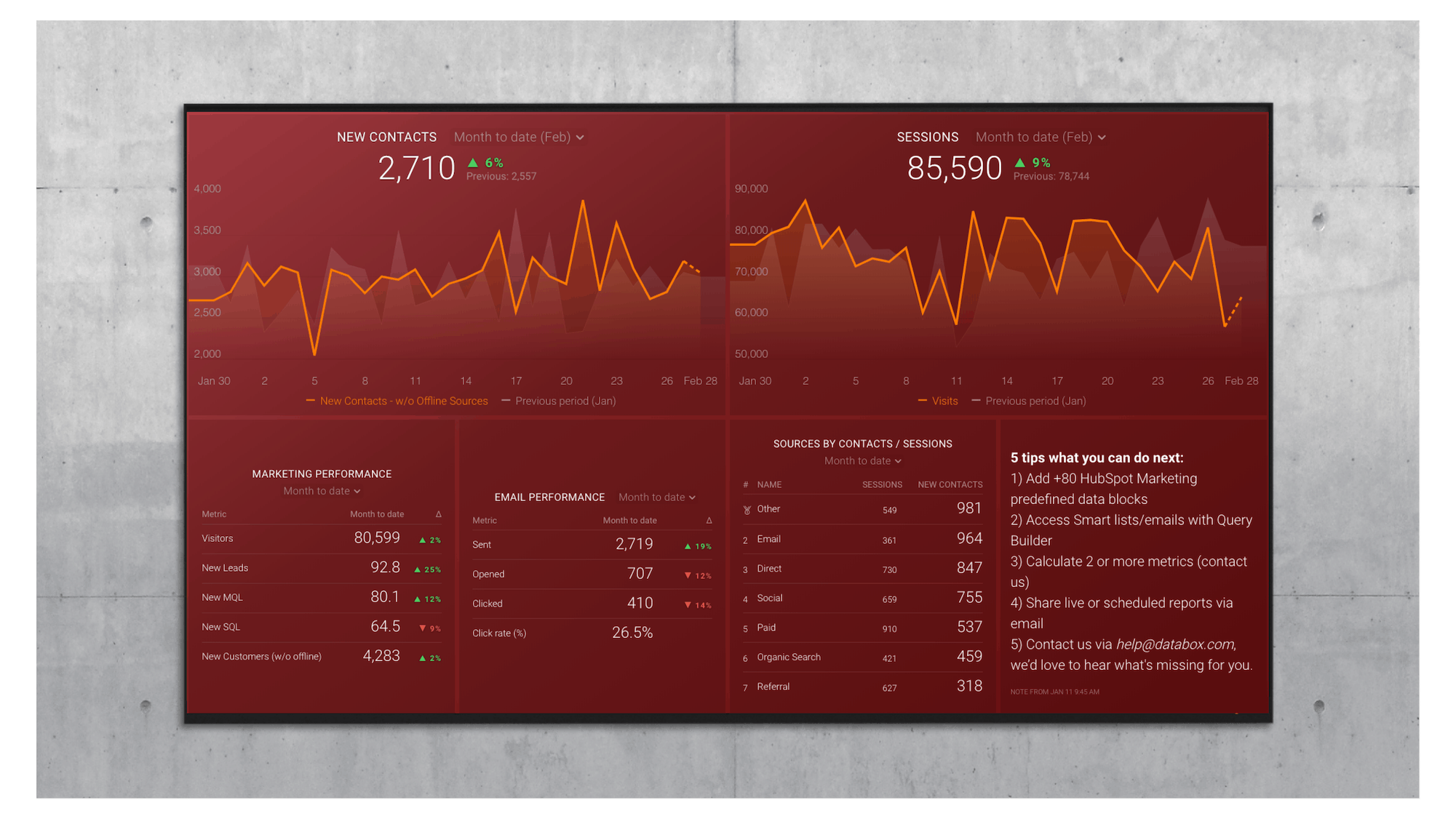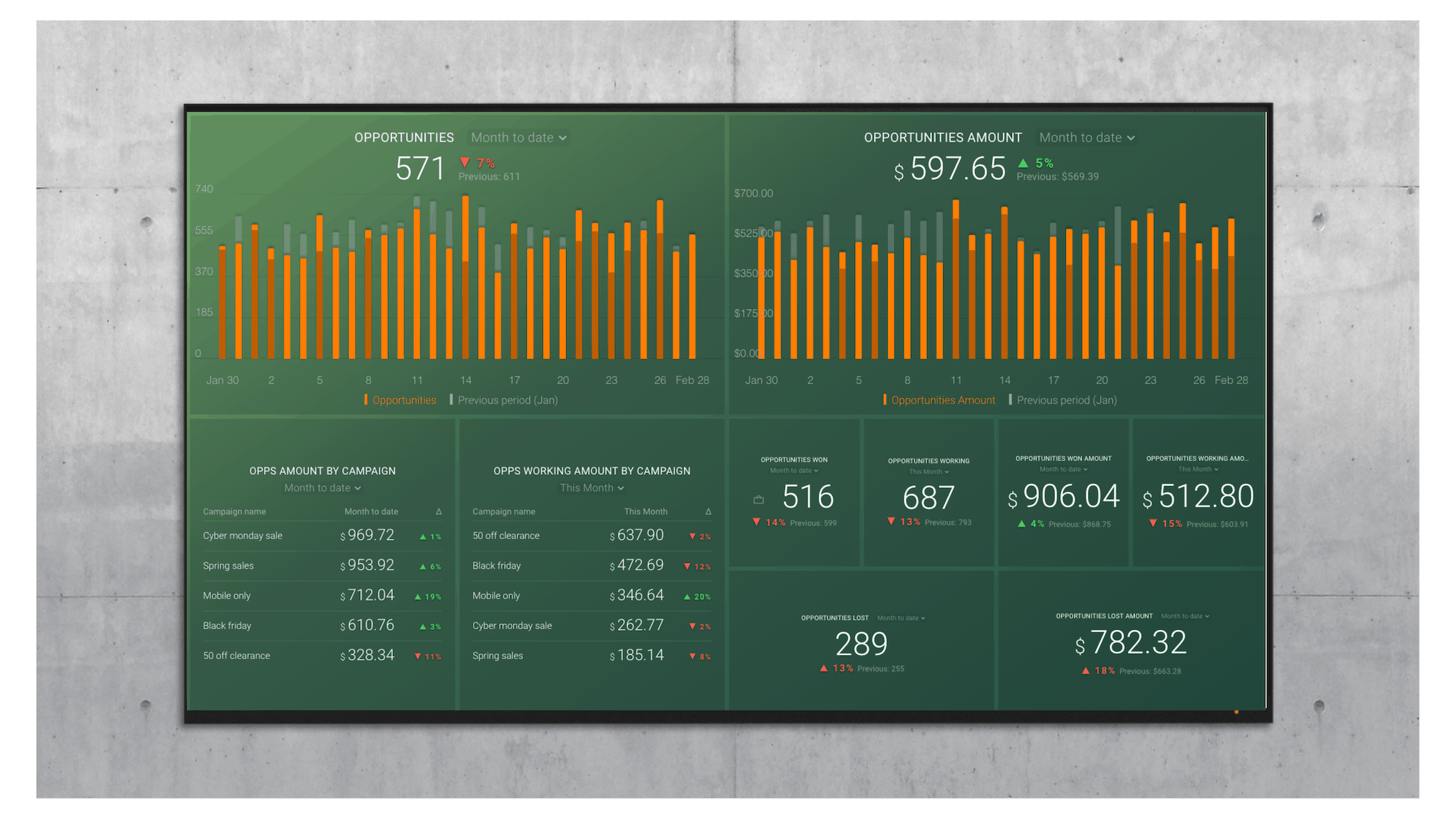Table of contents
There are a lot of content marketing tools to choose from, but which are the best?
Which content marketing tools make your job easier with automation, help you come up with great ideas, let you measure the ROI of your investment in content, or simplify optimizing and promoting what you publish?
To find out, we asked 63 marketers to tell us about their favorite content marketing tools. The result: a long list of 38 content marketing tools that marketers can’t live without in 2019.
The top 5 most-recommended content marketing tools were:

All 38 recommended tools are categorized below—with information about what each tool does and how it helps content marketers optimize their work—broken into sections. Jump to the section you’re most interested in using the links below or keep scrolling to see the full list.
Discover the best content marketing tools for:
- Content ideation
- Creating content
- Sourcing content
- Optimizing content for search
- Publishing content
- Promoting content on social
- Promoting content via email
- Marketing automation
- Measuring content performance
Note: Some of the more robust tools in this list are good for more than just the category they’re listed in. For example, Ahrefs is in the SEO section, but it’s also a great tool for content ideation. HubSpot falls under marketing automation, but it’s also a content management system. So if you don’t find what you’re looking for in one section, keep reading to discover more options.
PRO TIP: Measure Your Content Marketing Performance Like a Pro
Struggling to track the impact of your content across platforms? We feel you. Thanks to Databox, fragmented data doesn’t have to hold you back anymore.
Our library of free content marketing dashboard templates puts all the insights and metrics you need in one place. No more jumping between reports!
Measure engagement: Track key metrics like likes, comments, shares across social media platforms to see what content resonates most with your audience. Analyze website traffic, bounce rate, and average time on page to understand how visitors interact with your content.
Optimize conversions: Identify high-performing landing pages and blog posts that drive the most leads using dashboards like HubSpot Marketing Lead Source. Analyze campaign performance and user activity for both organic and paid content with a Facebook Pages & Facebook Ads dashboard.
Improve SEO: See which pages rank highest in search results and drive the most organic traffic. Improve search visibility by visualizing key SEO factors like backlinks and domain rank.
You can easily set it up in just a few clicks – no coding required.
To set up a dashboard, follow these 3 simple steps:
Step 1: Choose a fitting template
Step 2: Connect your data
Step 3: Watch your dashboard populate in seconds
The Best Content Marketing Tools for Content Ideation
The backbone of any content marketing strategy is a backlog of ideas for content you can create. So when you run out of ideas, it’s disconcerting—to say the least.
These tools make it easy to jumpstart your creativity and fill your empty content calendar with an abundance of new ideas.
1. BuzzSumo
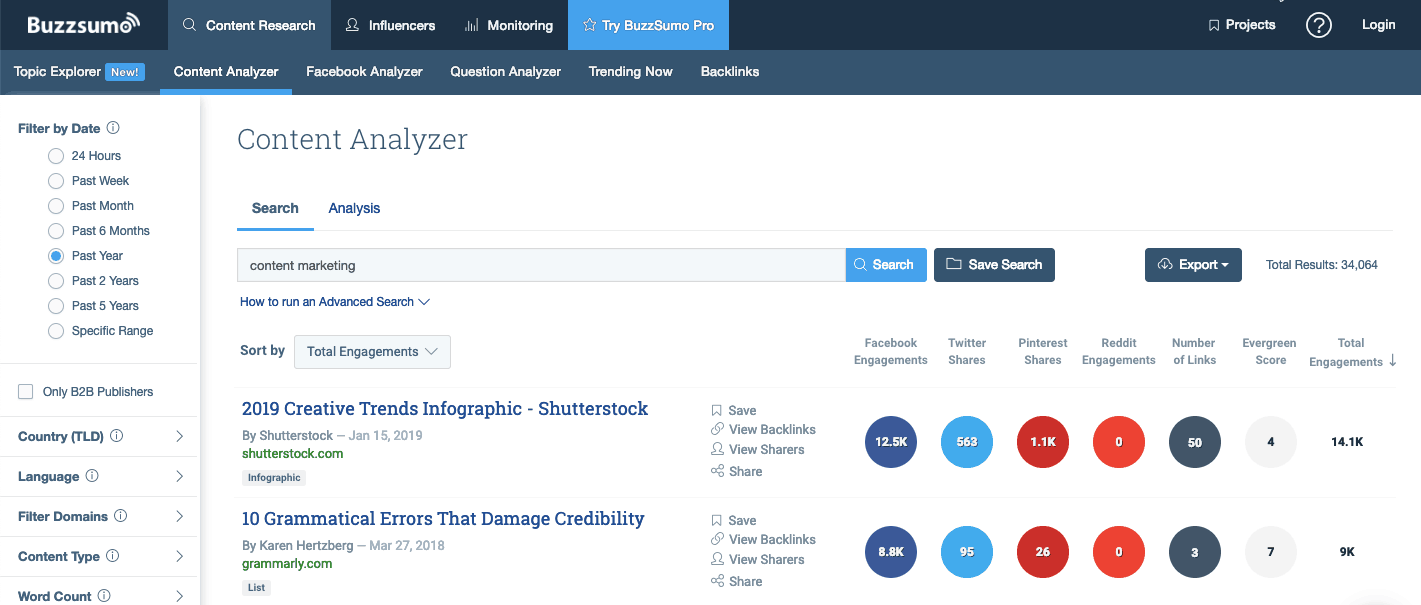
“BuzzSumo helps you save time when brainstorming new content ideas, especially when you’re entering a new niche,” says Shawna Newman of Skipblast Digital. “You can enter virtually any topic or keyword, and it shows you the most popular content created on that topic in the past year (or any other timeframe you set).”
“This helps with content research by showing you what types of articles and headlines get results,” says Stacy Caprio of Her.CEO. “You can also use the tool to identify top influencers and outreach opportunities based on who has shared similar articles in the past.”
“I can safely say that BuzzSumo is the most powerful tool for stealing competitors’ best content ideas,” says Syed Farhan Raza of SFR Digital. “Just plug in your competitor’s domain, and it produces a list of that competitor’s top-performing content based on social shares or links—whichever you prefer.”
“It allows you to understand how your competitors are competing with each other and how you can acquire a certain position in the market with your own brand,” says Adeel Shabir of SIA Enterprise.
And because you can see results by channel, “it helps you identify which channels you should focus on for the most success in building an audience and driving revenue growth,” says Alexandra Zelenko of DDI Development.
“Not only does BuzzSumo save a tremendous amount of time,” says SIXGUN’s David Pagotto, “it also increases the accuracy of your data, leading to better decisions around content topics to pursue.”
“This empowers you to create the best and most shareable content,” says Oksana Chyketa of Albacross.
2. AnswerThePublic
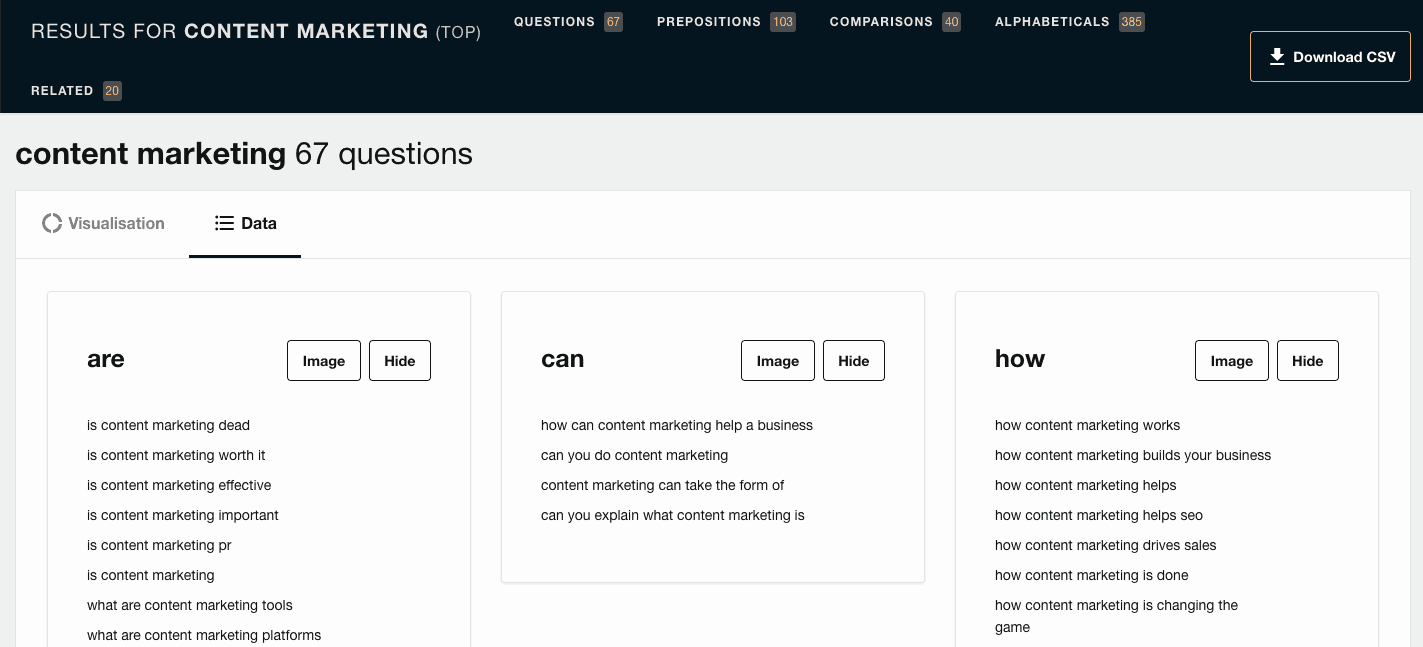
“AnswerThePublic is an amazing free source to help you figure out what questions people want answers to,” says Nate Masterson of Maple Holistics.
“Although it’s fairly simple, it is a great resource for any content marketing campaign. It’s perfect for generating content ideas, finding long-tail keywords, and earning featured snippets in Google’s search results.”
“If you ever find yourself stuck and out of ideas, AnswerThePublic is free to use a few times a day (so search sparingly).”
3. Feedly
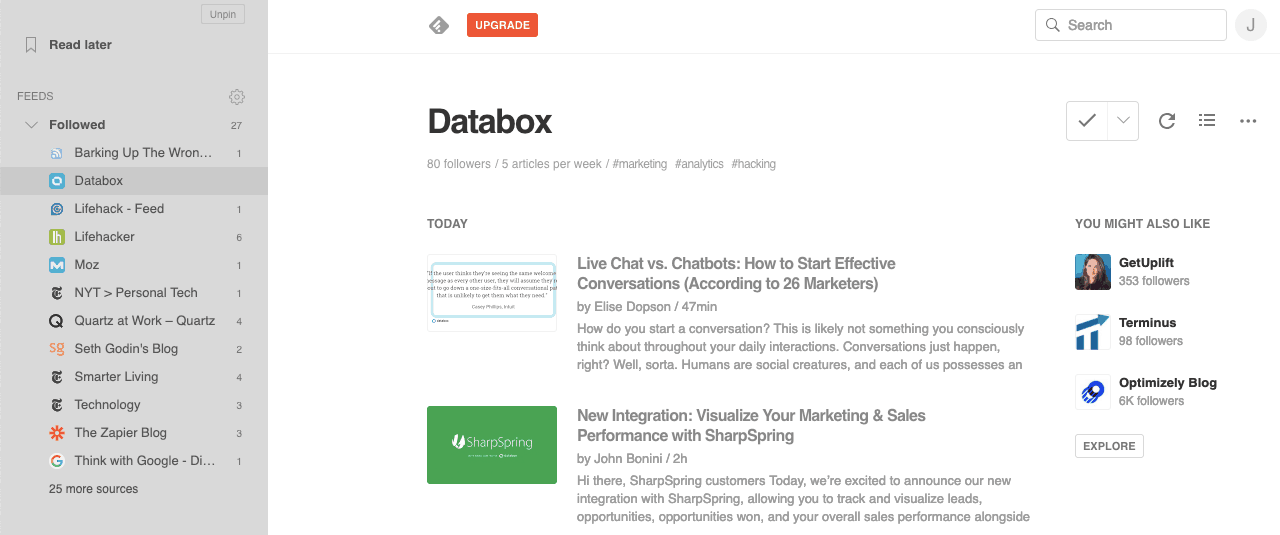
RSS readers started to fall out of favor once social media took over as a great place to discover new content, but for me, there’s no better tool than Feedly for keeping track of what my favorite blogs (or competitors’ blogs) are publishing. It shows me every new blog post the sites I follow have published, all in chronological order.
Feedly is also the source of most of my new content ideas. Sometimes, reading a post—or even just a sentence in a post—triggers an association in my mind that transforms into an idea for a piece of content. Other times, I come across a piece that’s good in concept but poor in execution, so I set out to write something better.
I set aside time in my schedule for reading new articles in Feedly at least once a week, and the “Ideas and Pitches” document in my notes app is never blank.
The Best Content Marketing Tools for Creating Content
Once you have a big backlog of content ideas, it time to pick a topic and start creating your content. You’ll obviously need a word processor like Google Docs or Microsoft Word, or you could just write directly in your website’s content management system.
If you’re a writer, getting words on a page is the easy part (or at least natural). The more difficult tasks are creating images and videos to accompany your content, editing your own work, and organizing your content into a central place to enable efficient collaboration.
For those tasks, these tools help.
4. Lumen5
“Lumen5 uses AI to turn your existing blog content into social videos,” says Christabelle Tani of Brand chemistry. “It’s extremely intuitive and comes with a wide range of motion videos, images, and music that you can search for and apply to slides. It also has templated themes.”
“It helps amplify your content, getting your message across to those with short attention spans on social platforms. Someone might not be motivated enough to click through and read an entire blog post, but they may be happy to watch your video with the sound off when it appears in their feed).”
5. Hemingway App
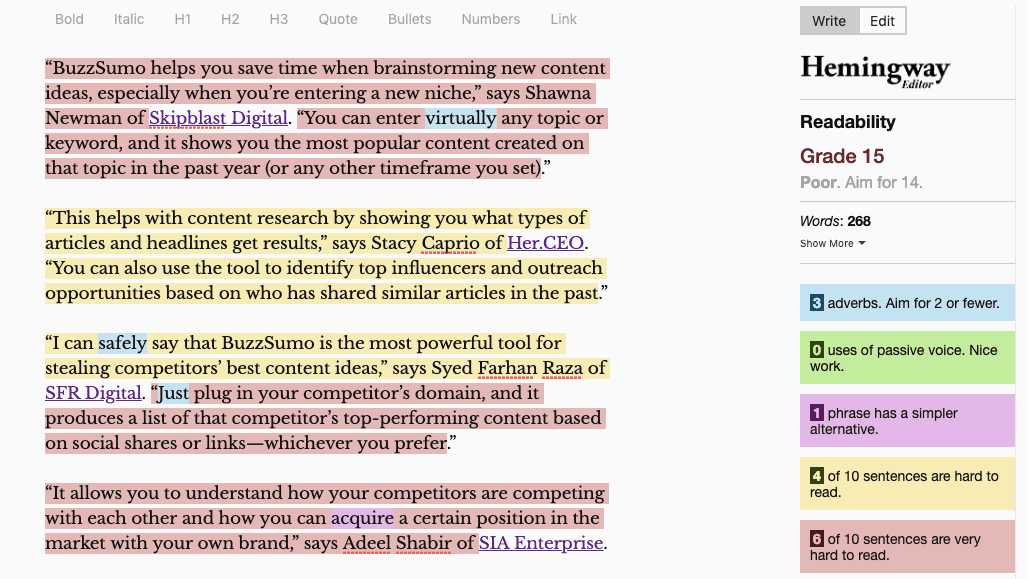
“Hemingway App checks your writing for readability,” says Jakub Kliszczak of CrazyCall. “It gives you a grade that corresponds to different grade levels in the U.S. school system, highlighting complex words and phrases. It also identifies uses of passive voice and unnecessary adverbs, making your writing more bold and direct.”
“It helps me tailor what I write to my target audience, which leads to better traction and engagement.”
6. GatherContent
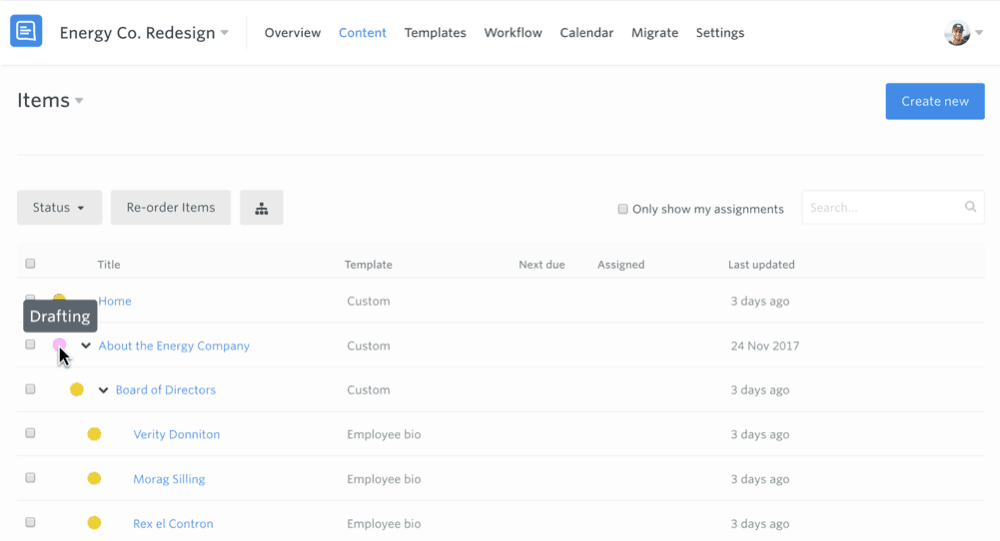
“GatherContent is a very useful tool for gathering and organizing all the different types of content you and your team produce,” says Thorstein Nordby of Nettly.
“Instead of using a set of disparate tools like Word, Excel, or Google Drive, you can put all your content projects in a place where all stakeholders can easily access it. That way, everyone knows where to find the latest version, and it’s really easy to collaborate on content with others.”
“You can also build content templates to create easy-to-follow guidelines and default structures for all contributors. This ensures that you get the content you need, within the word limit, in a consistent format.”
“For us, GatherContent has created a single source of truth when it comes to content. Nobody edits in different tools, and that saves our editors time because they don’t have to merge content and notes from various sources.”
7. Beacon.by

“Beacon.by makes it easy to create lead magnets, and it hosts the lead magnets for you,” says Michael Su of Wokflow.
To use it, all you need to do is import an existing blog post and choose a template (ebook, checklist, resource guide, workbook, or email). Beacon.by does all of the difficult design work for you, adding images, selecting fonts, and creating templates for different page types.
It’s an easy way to transform your existing content into lead magnets without spending days designing it yourself or hiring a designer.
8. Grammarly

In addition to BuzzSumo, DDI Development’s Alexandra Zelenko also recommends Grammarly. “It helps you catch spelling and grammar mistakes, missing words, incorrect word usage, and overused words when preparing content.”
9. Kapwing

Julia Enthoven of Kapwing recommends her company’s own tool: “Kapwing helps people edit photos, video, and GIFs with simple, browser-based tools.”
“Content marketers can optimize their videos for social media by resizing, adding subtitles, trimming, and overlaying watermarks. Or they can create relevant content with the Collage Maker, Meme Maker, and Montage Maker.”
“Instead of needing to hire expensive video editors or fire up heavyweight desktop software, content marketers can curate, edit, and make videos themselves with Kapwing’s fast tools.”
10. Canva

Canva, a recommendation from Science Soft, Alina Moskalova, makes it easy for non-designers to create designs for their websites, blogs, and social media profiles. Choose from its size templates to build images that are the perfect size for every channel, then select from pre-designed templates and edit them to make them your own.
You can also build graphics from scratch using backgrounds, photos, icons, shapes, fonts, and illustrations created by professional designers. Some premium assets cost $1 each, but if you choose carefully and just need to create simple images, it’s easy to create them for free.
The Best Content Marketing Tools for Sourcing Content
If you’re not a writer, getting words on a page might be the hardest task for you—if not outright impossible. But with these tools, it’s easy to outsource your content needs and find writers to create content for your company website, blog, or social media posts.
11. Zerys
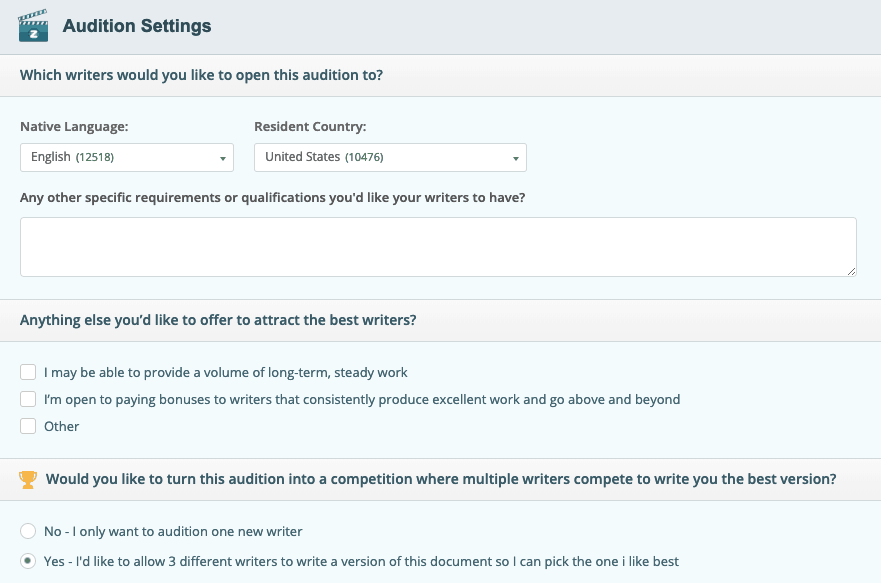
“Zerys is a marketplace platform that connects writers with companies/individuals who have content needs,” says Rizen’s Will Rizen. “For us, it eliminates the need to pay for writer overhead in many scenarios and also helps us easily scale a client’s content needs.”
“We wanted a great content strategy,” says Ashley Godfrey of APA Services. “As a marketing director with no help, I really needed a great group of writers. Zerys gave me just that.”
“The platform allows us to scale content creation for topics needed on our own blogs and client blogs,” says Mike Gingerich of Digital Hill Multimedia. “We can network to find writers who are skilled in that content area and who can write content that’s geared to our specifications.”
“We’ve tried a number of content marketing platforms over the years,” says Bright Oak’s Zach Mettra, “but we’ve found Zerys to have the most talented and specialized writers, coupled with a user-friendly platform to simplify the content creation process.”
“Once a writer is selected,” says Christine Penchuk of Search Strategy Marketing, “an agency can assign blog topics and deadlines that align with the schedule/frequency that the client and agency have agreed upon.”
“Once the content is complete, Penchuk continues, “the agency reviews it and can choose to publish it or pass it along to the client for final approval or edits. There are also other ‘white-glove’ services offered by Zerys for editing, etc.”
“The content marketing platform for agencies offers solutions to map out your editorial calendar, share content deliverables with your clients, and much more,” says Dominic Hill of Visibilitii.
“Zerys saves us time by not having to go to a variety of different sources and freelancers to get content delivered,” says Emilio of WSI ALM. “It makes it easy to get writers and revisions—and also to audition for new talent.”
“Zerys has helped me and my clients automate content generation, get better SEO results, build better branding online, and gain access to a dependable team that produces quality content with a quick turnaround,” WSI Digital Marketing’s Ila Awasthi says.
12. Textbroker
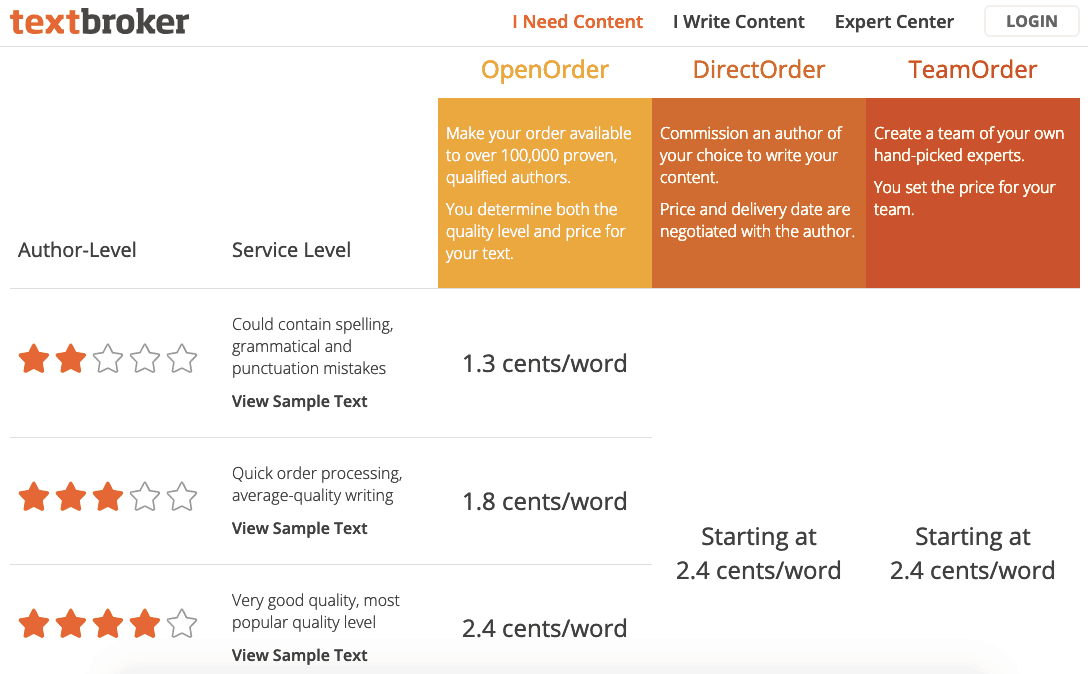
Colibri Digital Marketing’s Andrew McLoughlin recommends Textbroker for finding freelance writers.
“We generally prefer to keep our content marketing in-house, but in some cases, it’s more cost effective to outsource projects to third parties. Textbroker puts us in touch with a pool of freelance writers and gives us an easy way to pay for their services, regardless of where they are in the world.”
“It saves time when we’re in a crunch, and in some cases, it’s more cost effective to outsource smaller projects.”
13. WriterAccess
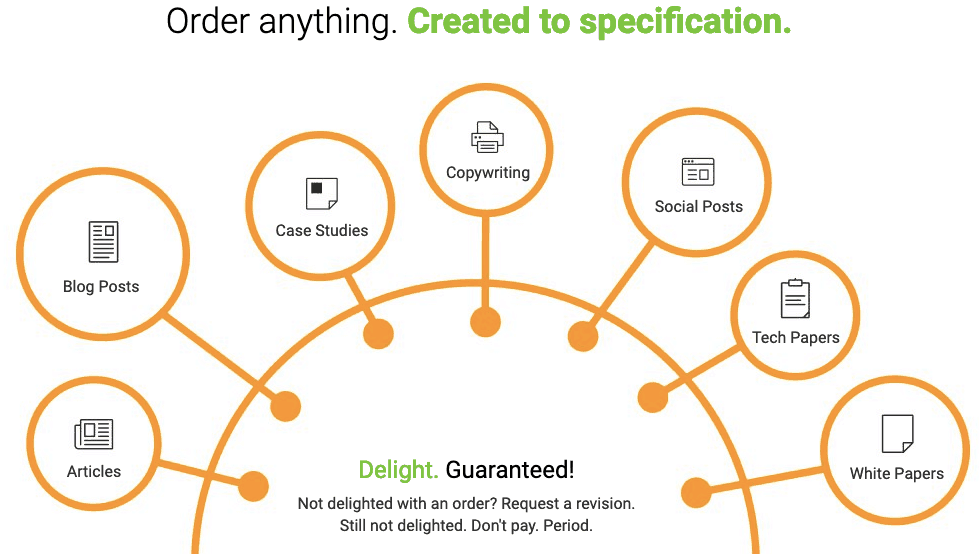
“WriterAccess is a marketplace where businesses can hire freelance writers,” says Inflow’s Alex Juel. “There are writers of all skill levels, from 3-star to 6-star, and there are more than 15,000 writers—all with their own areas of expertise.”
“Businesses can search writer profiles to find writers with the writing skills and level of expertise that they need. You can order any type of content—articles, product/category copy, ebooks, whitepapers, etc.—and you can also fine-tune the order to your needs.”
“For example, you can create a content brief, send documentation to the writers, require specific keywords, request metadata, and so on. Businesses have full control of the order, including setting deadlines, working with a pool of writers, and even creating a ‘love’ list of writers so that you can work with only your favorite writers on specific projects.”
“Whenever I get a new client, I search WriterAccess for people with expertise in my client’s industry. We only hire 5-star and 6-star writers, which require hardly any editing. Once we find a writer we like, we work with them to find our client’s voice.”
“Over time, the writers usually require less management, and all I need to do is send article topics, word counts, and keyword research. I even have some writers who send me topic ideas. Using a content marketplace like WriterAccess saves us a ton of time.”
The Best Content Marketing Tools for Optimizing Content for Search
Whether you’re conducting keyword research to come up with topic ideas, looking for ways to earn more links to your published content, or trying to refresh old content to boost search rankings, these tools will help.
14. Ahrefs

“Ahrefs is an SEO tool that helps with extensive keyword research, competitor analysis, SEO audits, content performance evaluations, and so much more,” says Time Doctor’s Carlo Borja.
“It provides you with everything you need for SEO,” says Nicolas Straut of Fundera, “including ideal websites to pitch content to, keywords to target with new content, and competitor monitoring abilities to better compete for links and search rankings.”
“Ahrefs has been a game changer for us in several ways,” says Ian Wright of Merchant Machine. “We’ve generated a lot of new content ideas using its keyword and content tools. We’ve researched competing websites and found ideas for content we would never have thought of creating. And we can prioritize those ideas based on the value of the content.”
“If we’re producing a new piece of content, we want it to get as many shares and links as possible,” says Sean Morrissy of Flowers Across Sydney, “looking at what has worked in the past allows us to better plan our own content so that we’re not investing resources into pieces that flop.”
“This saves us time,” Morrissy says. “Trying to figure this sort of stuff out on your own can be time-consuming. It also makes us more successful because our content does a lot better now.”
15. SEMrush
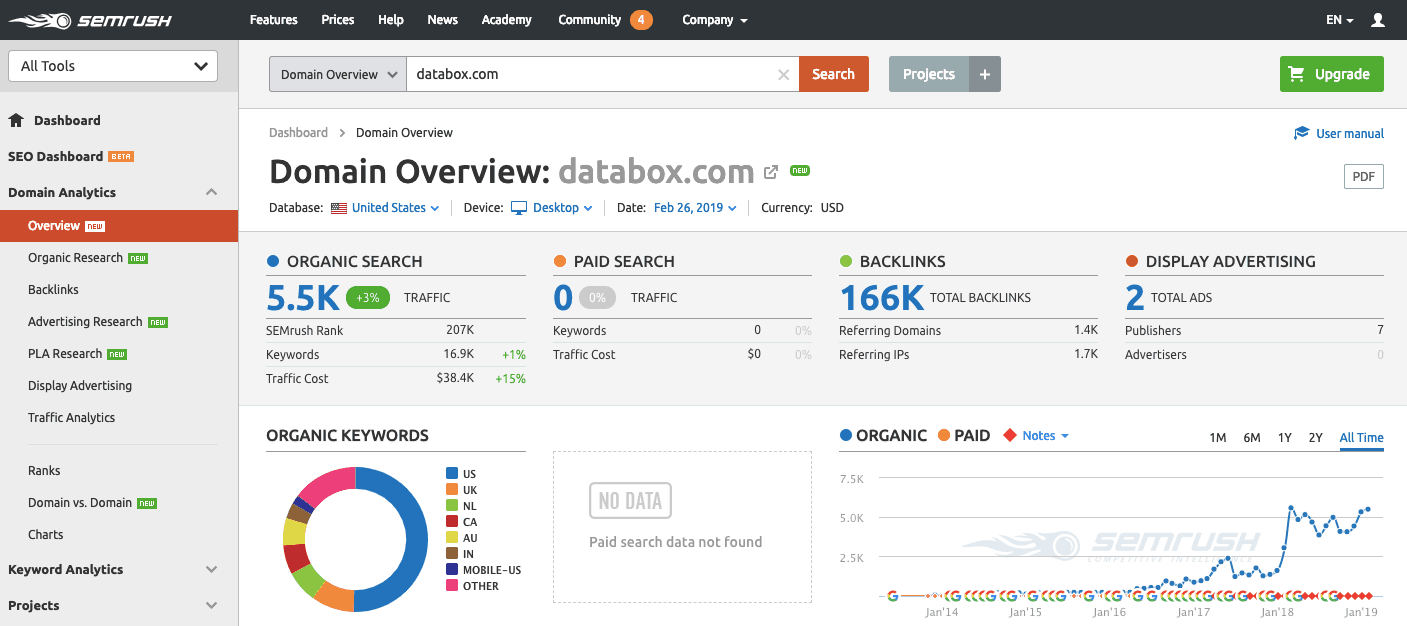
“SEMrush is a wonderful content marketing tool that helps us with all of our SEO needs,” says Hima Muralikrishna of BrandLoom Consulting.
“When it comes to SEO, there are a lot of things that you need to take care of to promote a website—from creating the right keyword strategy to fixing technical issues. With each step consisting of many other sub-steps, it all requires expertise and attention. But all of your backstage efforts become irrelevant if they don’t lead to actual business results.”
“SEMrush developed the report builder: an integrated PDF-constructing tool that allows you to create customized white-label reports with data from the SEMrush toolkit, Google Analytics, or any other SEO tool of your choice. It helps is in 90% of our publications and allows us to move fast and really scale results for clients.”
Editor’s note: Download this free SEMrush template and instantly visualize your top keywords by position, visibility trend, estimated traffic, and more.
16. MarketMuse

“MarketMuse uses AI and machine learning to provide a robust analysis of your content, show you where your holes in topic coverage are, and help you determine which keywords you need to include for the topics that you write about,” says Best Company’s Sarah Hancock.
“Essentially, you just write or paste a piece of content into the platform, and then input a keyword that you want that piece of content to rank higher for.”
“MarketMuse provides you with a ‘Content Depth Score,’ which is basically a measure of how well your content is covering the topic, and a ‘Target Score,’ which is the score you should aim for to have the most in-depth content for that particular keyword.”
“You can also see how your content stacks up against top-ranking competitive content for that keyword.”
“To help you improve your Content Depth Score, MarketMuse churns out a list of topics and keywords that should be included in that piece of content to help it better address searcher queries and rank higher in the SERPs.”
“We’d never had a solid content optimization strategy prior to adopting MarketMuse, but since adding it to our toolkit, I feel that content optimization has become one of our strengths.”
“We’ve seen a big return on it, too. We put MarketMuse to the test by using the tool to optimize the content on 60 pages of our site around target keywords that we wanted to rank higher for.”
“After four weeks, the ranking for each target keyword improved by approximately two positions on average—all without making any changes to the pages outside of the content optimizations.”
17. Clickflow
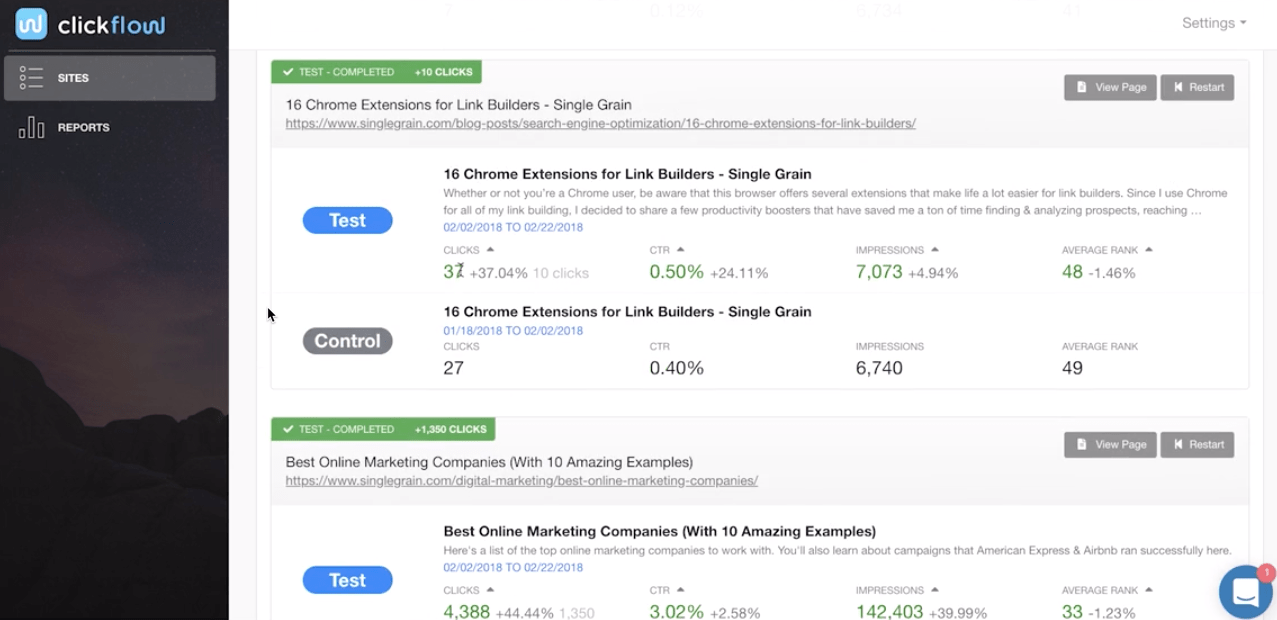
“The one tool that has delivered us the most change in both SERP position and click-through rate is Clickflow,” says Best Company’s Chad Zollinger.
“It’s a relatively new tool that tracks your title tag and meta description changes and compares the results to the old title tag or meta description. The data for all of your running and completed tests is rolled up in an easy-to-read manner, giving you everything you need to perfectly optimize future title tags.”
“Over time, you learn exactly which title tag changes have the most positive impacts on your site clicks. It also identifies the pages on your site that could benefit the most from a title tag change—this is especially useful because research eats up a lot of our time as content marketers.”
“Clickflow put my title tag/meta description research and tracking all in one place and automated the whole process. I save time and make money. I’m not exaggerating when I say that Clickflow completely changed how I consider title tag changes; now, they’re my go-to tactic when I want to optimize a page for clicks.”
18. Alexa

“The Alexa SEO marketing tool gives you all of the tools required to optimize your SEO strategy,” says Fisher Unitech’s Jackie Tihanyi.
“Some of its features include bi-weekly SEO audits of our entire website with an extensive report of recommended actions, a competitor backlink checker, a keyword difficulty tool, and a share-of-voice tool to see how your competitors’ keywords stack up against yours.”
“Using Alexa has allowed us to improve our overall SEO strategy on our website, and it’s given us more insights into competitor keywords. Before using Alexa, I was spending a lot of time visiting different sites to find competitor keywords, conduct SEO audits, and find backlinks, and now I have it all in one place.”
The Best Content Marketing Tools for Publishing Content
Once you’ve come up with ideas, created your content (or had a freelancer create it for you), and optimized it for search, it’s time to get it into your content management system and live on your website. Here are some of our respondents’ favorite tools for publishing content.
19. WordPress

“WordPress is a content management system that’s quite popular,” says ProfitPress’ Gabriel Antonio. “In fact, it powers one-third of websites around the world. Its flexibility and versatility make it awesome for content marketing, especially for larger companies with complex needs.”
“We use WordPress to create, publish, promote, and measure our content marketing efforts.”
“Its new editor, Gutenberg, provides incredible flexibility and customization options. There are advanced builders available for more complex landing pages and other content presentation needs, like great looking content archives.”
“There are several awesome SEO plugins available—most of which are free—that help you write content that performs well in search: improve your writing, find internal link opportunities, designate cornerstone content, and more.”
“When it comes to publishing, WordPress is second to none. With great plugins available for editorial flow, content review, and content scheduling, it has everything you need.”
“It also has integrations with dozens of social media and marketing platforms that make it easy to promote your content. Even better, these integrate well with the content publishing flow so it’s completely seamless, and it automatically publishes content in elegant ways to multiple social media platforms and other marketing channels.”
“WordPress’ flexibility also allows it to easily integrate with content measuring tools and analytics. It lets you use plugins to view Google Analytics stats for each individual article on the article’s administration page—in addition to overall site analytics for different time periods—without leaving the app.”
“It also integrates with our SEO tracking tools to tell us how our content is performing for our target keywords, including attractive ‘low hanging fruit’ opportunities.”
“Overall, WordPress saves us a lot of time, saves us money, and delivers better results than our old process of doing it all manually.”
20. Wordable
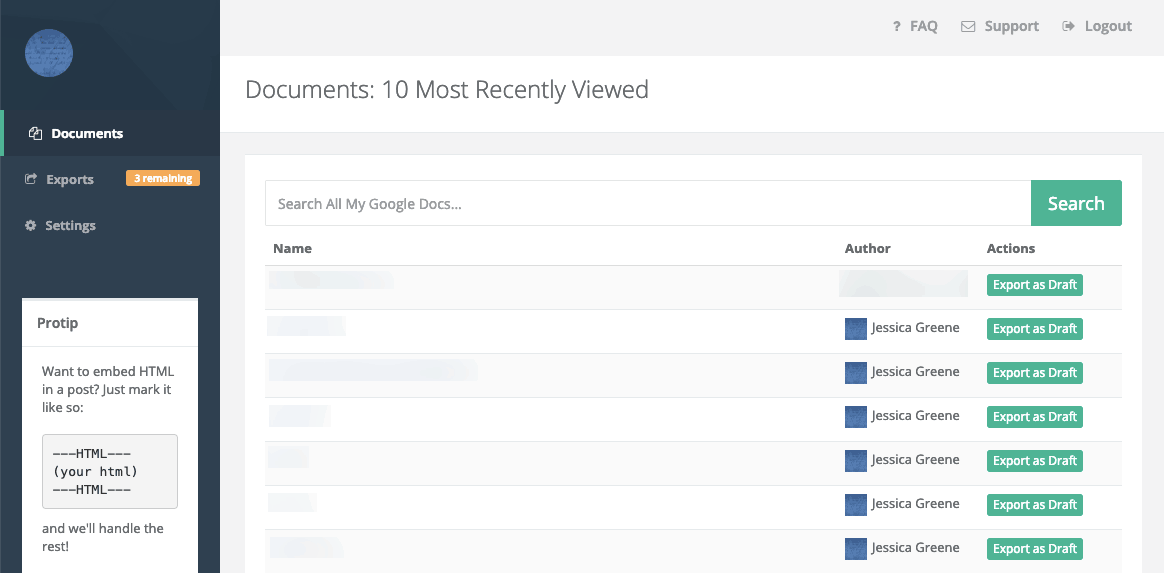
“Wordable instantly uploads Google Docs as WordPress posts, keeping all your images, styles, and fonts intact,” says Emil Shour of Chili Piper.
“We used to have to copy and paste everything from Google Docs into WordPress and lose all our formatting. Plus none of the pictures you add can be copied over into a WordPress post. Wordable takes care of all of this, saving me 30-60 minutes on every single post we publish.”
The Best Content Marketing Tools for Promoting Content on Social
The first thing most marketers do after publishing new content: post it on social. These tools simplify that task, making it easy to plan, schedule, and automate your social media content promotion efforts.
21. CoSchedule
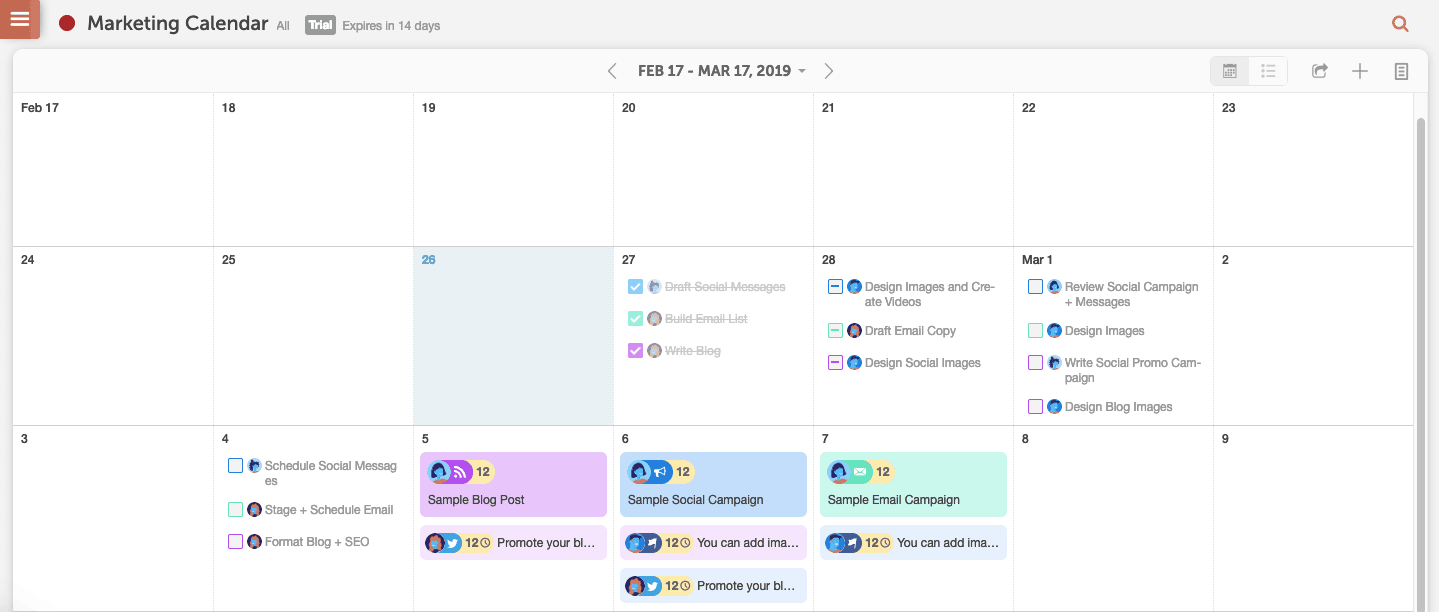
“We use CoSchedule as our go-to editorial management software,” says PayJunction’s Christina Lavingia. “I’ve used a number of systems—everything from Excel to some of CoSchedule’s competitors—and I’ve never found one solution that accomplishes so much.”
“You can create templated workflows for different content types and receive daily notifications of all of your tasks that are due. It has in-app messaging, drag-and-drop functionality, and allows you to schedule social messages within the software. We don’t use additional social media solutions; it’s all built into our editorial calendaring.”
“The software generates reports, too. You can attach files to projects, and it has a nifty integration with WordPress.”
“CoSchedule saves us time since we don’t have a social media coordinator to help us promote our content. It helps us keep track of all of our tasks and manage the workflow of our emails, press releases, blog content, social posts, and newsletter—all from one system.”
Advice Media’s Joe Sloan says CoSchedule is his favorite content marketing tool, too. “It helps us keep all of our content on track and on time. Plus, it allows our teams to communicate easily and ensure our projects meet their deadlines.”
PRO TIP: Looking for centralized marketing reporting software that is able to report on conversions, SEO performance, Blog metrics and more. Databox can combine metrics from over 100+ tools within a few clicks.
22. Hootsuite

“Hootsuite helps you curate content from different sources to share on your social media accounts,” says Alex Altyhin of HandyKith. “It includes a tool for editing pictures, lets you schedule automatic postings of content, and shows you in-depth analytics to help you see what’s going right—and what’s going wrong.”
“It helps us keep track of what post is going out on what day, which saves us a lot of headaches. Also, being able to schedule out our posts weeks—or even months—in advance saves so much time.”
23. Buffer

“Using Buffer, you can automate the publishing of your posts on all of the popular social media channels,” says Jakub Kliszczak of CrazyCall.
“I often have to share the same content on two or three different platforms simultaneously, but each of these platforms needs the proper personalization. For example, you don’t want to use the same hashtags on both Twitter and Instagram. Buffer allows you to customize the same post for each of the networks.”
“It’s allowed us to both save time and organize our content marketing in a very neat way. Thus, we can focus solely on creating valuable content—and stop worrying about technical stuff.”
24. Social Report
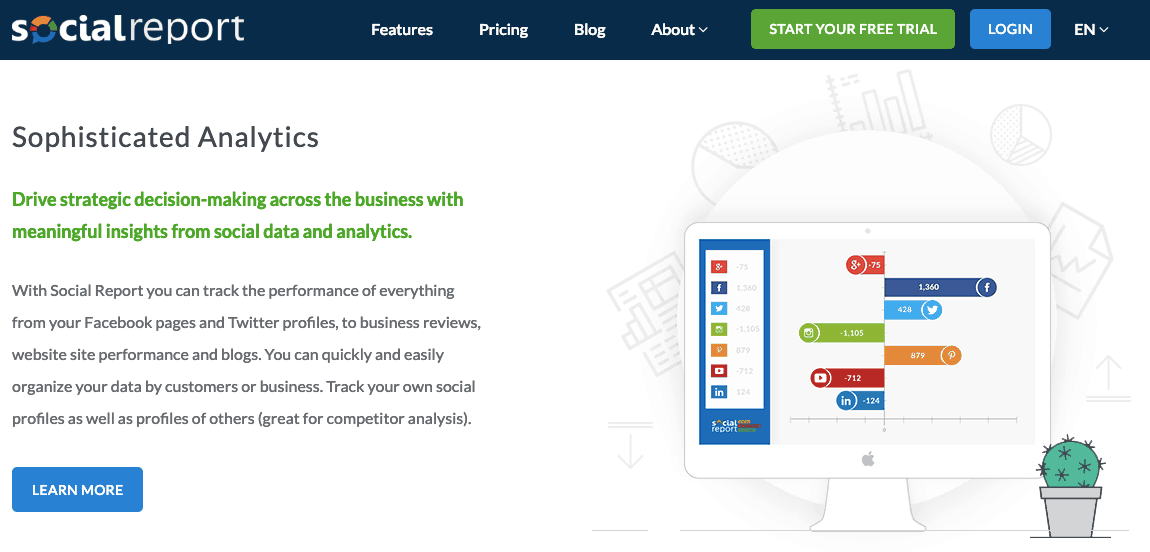
“Social Report allows us to schedule content in advance and publish on multiple networks at once,” says Empty Desk Solutions’ Brittany Hardy. “We can also access very detailed analytics about what the reach of the content is, who’s seeing and interacting with it, and how many clicks things are generating.”
“This is a very small sampling of things that the software actually does, and it’s literally a life saver for our team. The amount of time it would take us (or our clients) to manually schedule/post content is unbelievable.”
“Social Report saves us time, automates certain tasks, and alleviates stress since you can access everything you need from one dashboard even if you’re managing multiple social media accounts.”
25. Mix
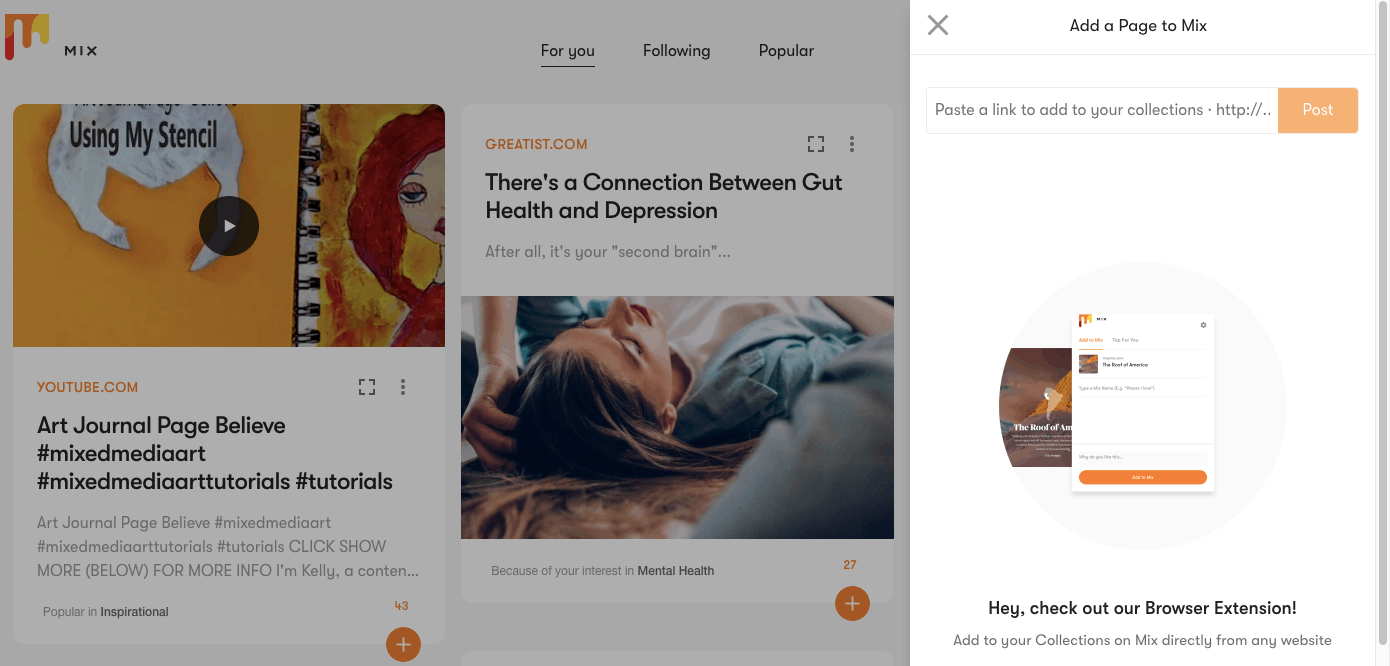
“Mix (formerly StumbleUpon) is a great platform for promoting your content and getting it discovered,” says Jonathan Aufray of Growth Hackers.
“We use it to promote our clients’ content. It’s saved us a lot of time, and it’s saved our clients a lot of money.”
26. Missinglettr
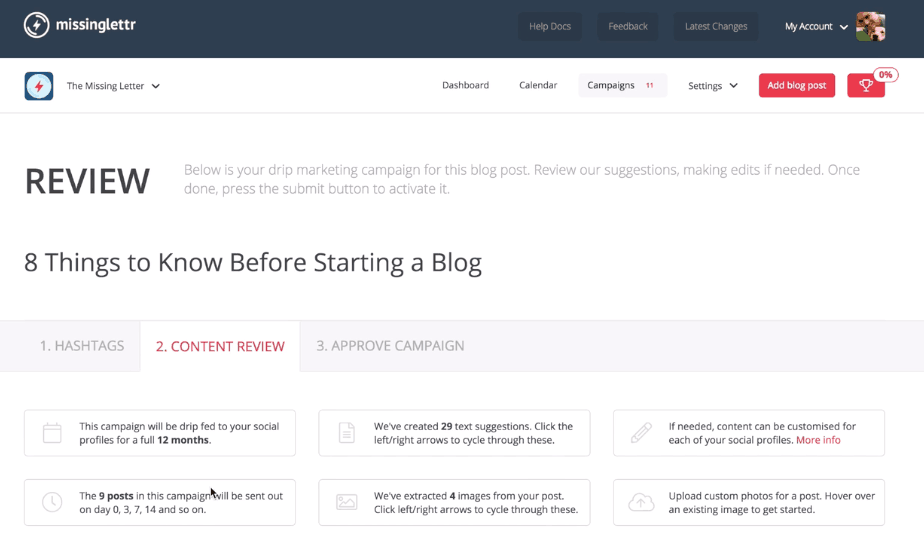
“Missinglettr is good for distributing content using social media,” says Print4Hospitality’s Richard George. “It will take a blog post, divide it into multiple posts, and schedule them to specified social media channels.”
“It’s an excellent timesaver for any content marketer. It makes light work of driving traffic from social media to a blog post.”
27. Kred
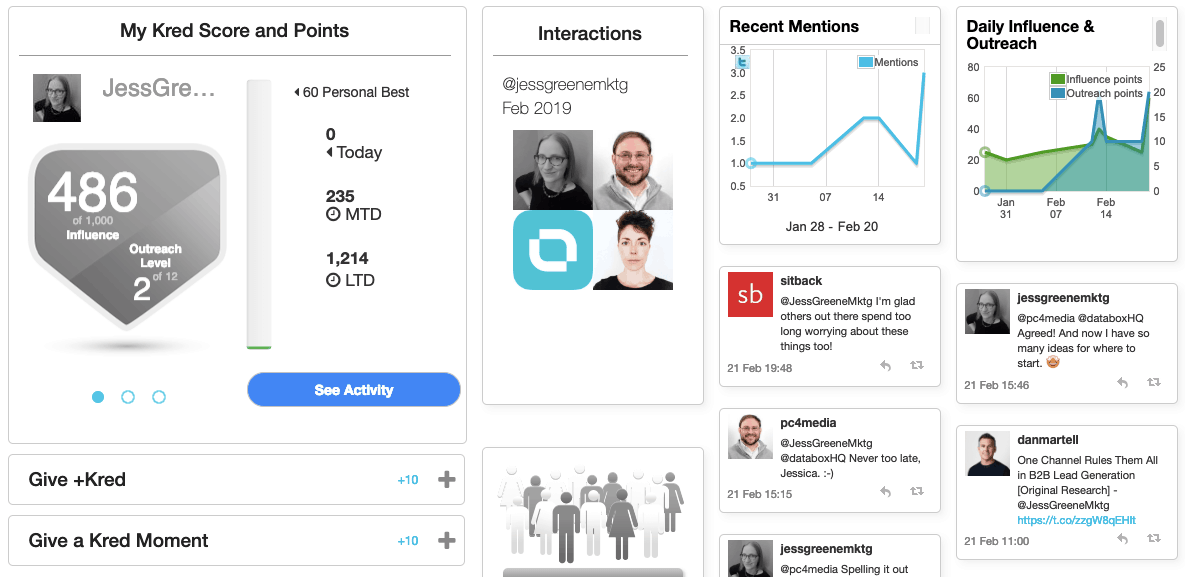
“Kred analyzes Facebook and Twitter data in order to connect you with the influencers who can amplify your content marketing efforts,” says Stuart Ridge of VitaMedica. “Additionally, it can help you become an influencer and improve your personal brand.”
“Creating great content is obviously the cornerstone of content marketing, but there is more work to be done. Kred can increase the reach of your efforts beyond your own audience and save you valuable time and money trying to do the same thing on your own.”
The Best Content Marketing Tools for Promoting Content Via Email
The next step: get your content into your email newsletter to get it in front of your most engaged readers. These tools help you promote your content via email, evaluate your email outreach efforts, and optimize your marketing emails for more opens and clicks.
28. Mailshake
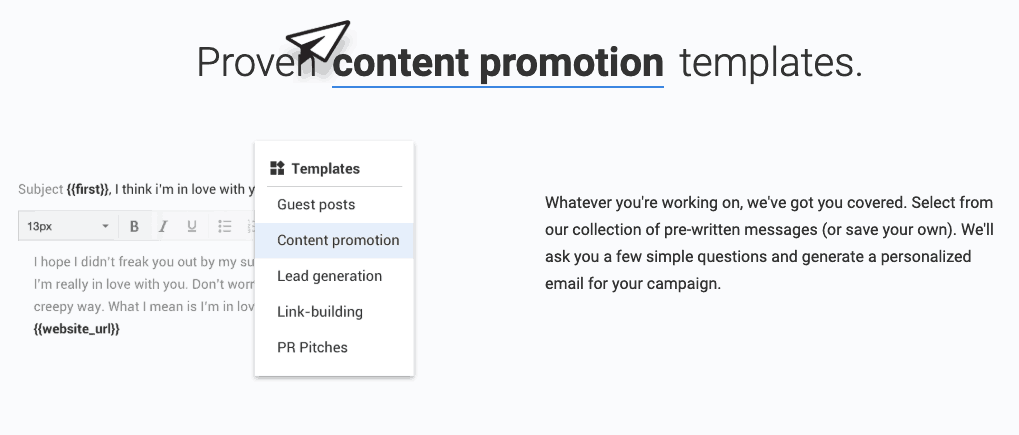
AmpMyContent’s Daniel Daines-Hutt says his favorite content marketing tool is Mailshake.
“If you want to see ROI from your content, you need to be actively promoting it, and that’s what Mailshake does. It’s a simple tool for tracking email outreach.”
“You set up a campaign, email an influencer/journalist/blogger, and it’ll track campaign opens and replies. It uses AI to track your email content for spam, gives advice on how to improve your email, and more.”
“You can also set up specific follow-up automations based on if people reply to or open your email. We use this tool daily to help promote our own articles.”
“Another cool feature? If you’ve ever emailed someone before (for any campaign), it will let you know about it. This helps you to find that previous communication and reach out (and also not cold email them twice by accident).”
“We’ve been using Mailshake for around four months now. Most people will get around a 2% response rate from cold outreach. But with a little effort and Mailshake, we get around a 25% response (i.e. people linking to our content). It’s worth its weight in gold!”
29. Hunter
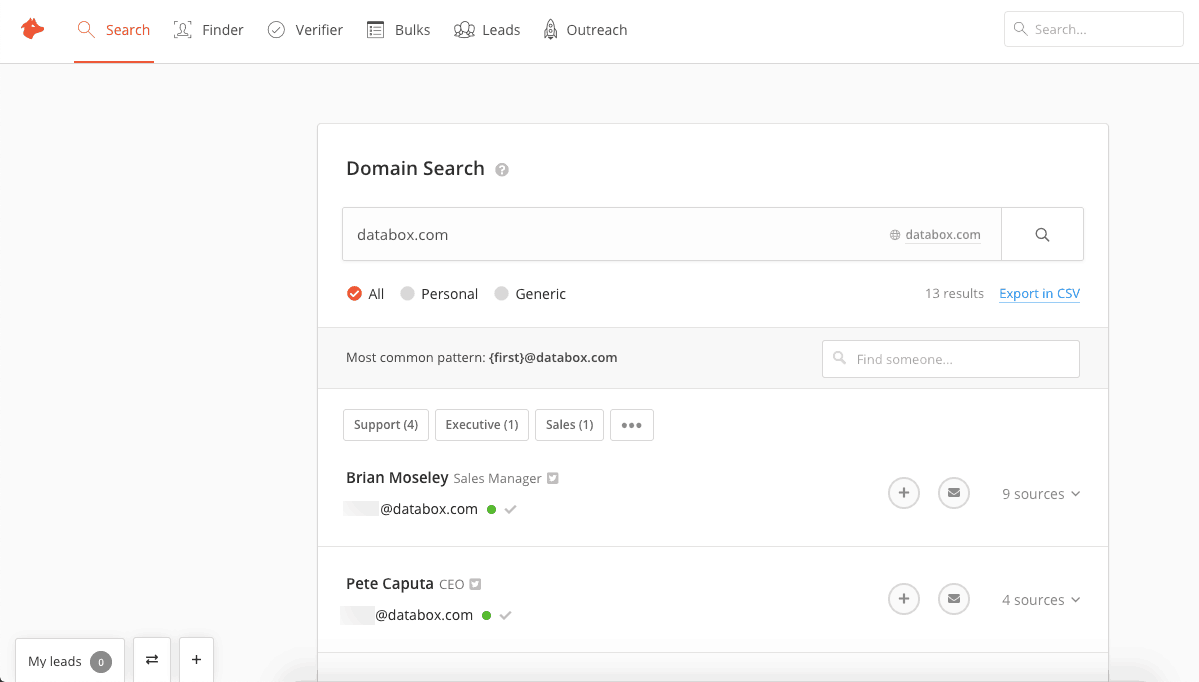
“Hunter scrapes the web for publicly listed email addresses,” says Catherine Giese of Fundera. “I use its plugin, and it’s amazing. It saves me so much time, and I think it beats out BuzzStream’s, Pitchbox’s, and RocketReach’s scraping abilities.”
“It also helps you identify patterns in company emails, so you can take an educated guess if you find someone on LinkedIn who you want to reach out to but isn’t listed in Hunter.”
“If you do any kind of email outreach for your content, Hunter is a must-have.”
30. BuzzStream
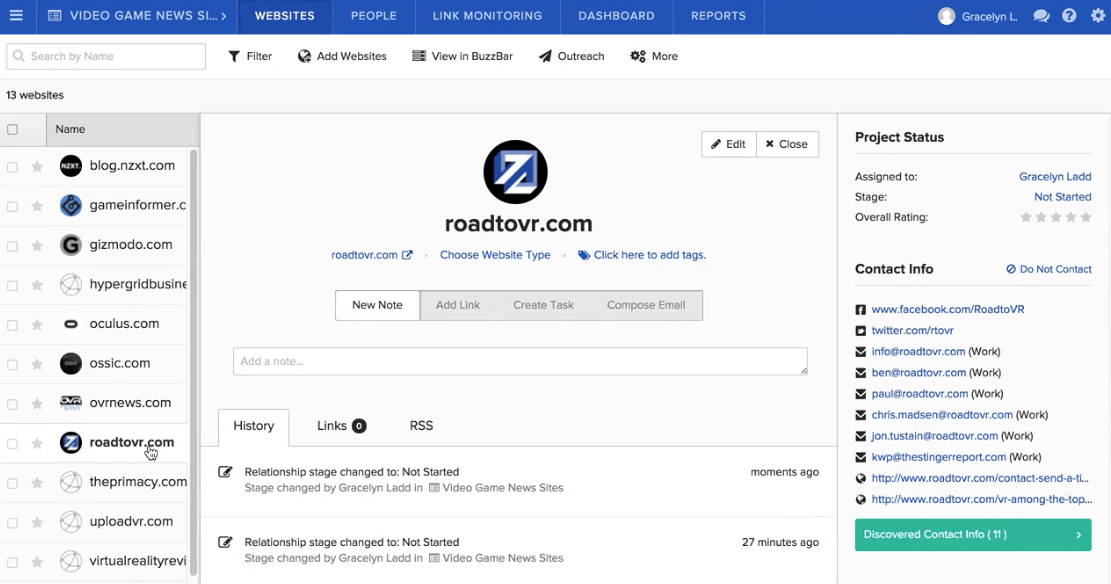
“The beauty of BuzzStream lies in the fact that you can track whether or not your email is opened, as well as the specific times and frequency in which it’s been opened,” says Smallpdf’s Hung Nguyen. “You can also use this tool to automate replies and import mailing lists for easy management. Think of it as a mini CRM, but for link-building/outreach.”
“You can reach out to writers and blogs that you wish to guest post on. It has a large database of influencers that you can filter by keywords, industry, posting activities, and number of Twitter followers. It’s a good tool for executing viral campaigns.”
“Often, it’s hard to track the performance of your pitches. Are they being opened? Is the email being passed around? Does the prospect take one look at your pitch before closing the email, or do they go back to it several times before replying—or not replying?”
“These are the kind of things that you can track with BuzzStream, which allows you to optimize every bit of content in your emails better—from the subject to the body and CTAs. In turn, improving your content will drive opens, clicks, and engagement.”
The Best Content Marketing Tools for Marketing Automation
Once you’re ready to start automating repetitive tasks—or if you just want to centralize all of your content marketing tasks—you’re ready to upgrade to a marketing automation tool.
These tools make it easier to market your product/services on multiple channels; automate social media, ad, and email drip campaigns; and collect and consolidate metrics from all efforts.
31. HubSpot

“We use HubSpot for all of our content marketing needs,” says Codal’s Jenna Erickson. “HubSpot is truly an all-in-one content and digital marketing tool.”
“HubSpot makes it easy to create content because they have a lot of templates that you can use,” says InTouch Marketing’s Samantha Walls. It helps us organize our leads and nurture them. And its social media automation is a life saver. It lets you schedule social media messages at different times and on different social networks.”
“HubSpot helps us create high-quality content, use advanced customer targeting, and manage our contacts/lists,” says ClearPivot’s Chantelle Stevenson.
“It’s helped us and our clients by allowing us to automate personalized emails, social ads, and more,” says Andrew Maff of Seller’s Choice. “For example, if a blog post is hosted on the Hubspot CMS, it allows us to see what the viewer is interested in. Then, we can target them with more content on things they’re interested in.”
“It’s made our marketing and sales easier because of its many integrations,” says Raul Tiru of GlobalOwls. “Plus, setting up automated email flows works really well within HubSpot.”
“Having access to all these tools in one CMS not only streamlines our content creation, but it also allows it to be more powerful,” says Kelly Wilhelme of Weidert Group. “Because HubSpot is also a CRM, marketing and sales teams can more effectively nurture and close inbound leads by delivering content that’s extremely relevant.”
“It’s a huge time-saver, and the metrics HubSpot provides are bar none,” says Metrix Marketing’s Michael Olenick. “It’s a one-stop shop, so it’s really the only software you need to run your business.”
Editor’s note: Download this free HubSpot dashboard and instantly track and visualize your marketing performance, including overall sessions, leads, and the top sources driving traffic and leads to your website.
32. SharpSpring
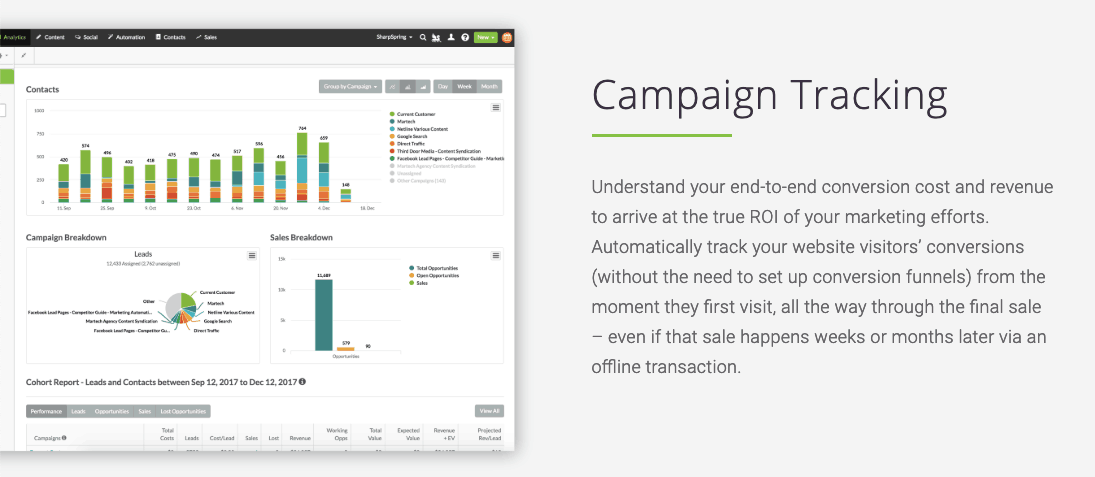
“SharpSpring is a CRM and marketing automation tool that helps marry both inbound and outbound marketing strategies and teams,” says Envision Creative’s Michelle Loughry.
“It’s good for behavior-based email automation, blogging, social content promotions, and managing contacts,” says Jitesh Keswani of e-Intelligence.
“It helps you keep track of leads and follow up with them, and it segments leads properly based on how visitors interact with your content.”
“SharpSpring makes it easy to schedule posts for social media platforms, and we also get to review statistics like reach, impressions, engagement, mentions, shares, and more.”
Editor’s note: Download this free SharpSpring dashboard and get a live view of opportunities in your pipeline, see your top performing campaigns, and more.
33. Pardot
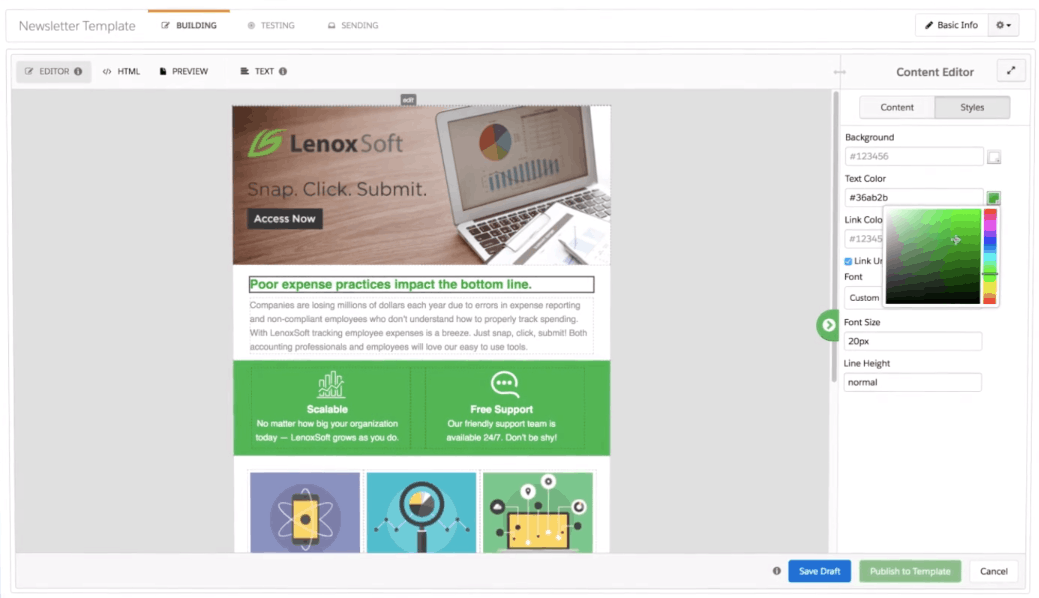
“Pardot is a B2B marketing automation tool that allows you to effectively create, curate, distribute, and measure the results of your omnichannel content marketing activities,” says Carolyn Lighty of eVolve Brand Marketing.
“I like Pardot best because of its extensive email and landing page template libraries and the ease of customization through HTML.”
34. Carrot quest
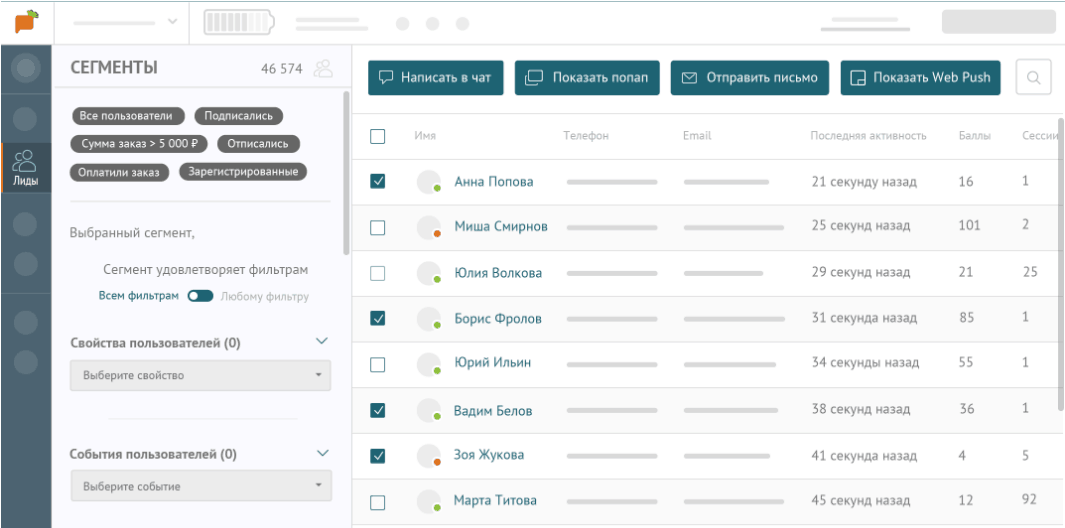
“Carrot quest works best for me out of all of the other, similar tools I’ve tried,” says Marie Fincher of Trust My Paper. “It automates the content marketing process and presents a wide spectrum of analytics.”
“Among all of its features, my favorite is its email marketing tool. It allows you to gather emails from all forms—even from users that didn’t submit. This way you can easily grow your number of leads.”
“If you’re working a lot with automated messages, A/B testing will point out your mistakes and suggest variations of your message that would work better. You can also check out detailed statistics on your links.”
The Best Content Marketing Tools for Measuring Content
You’ve come up with ideas, created your content, published it, and promoted it on multiple channels. Now it’s time to find out what content, tactics, and channels are making the biggest impact on helping you hit your goals.
These recommended tools make it easy to measure the performance of your content marketing initiatives.
35. Databox
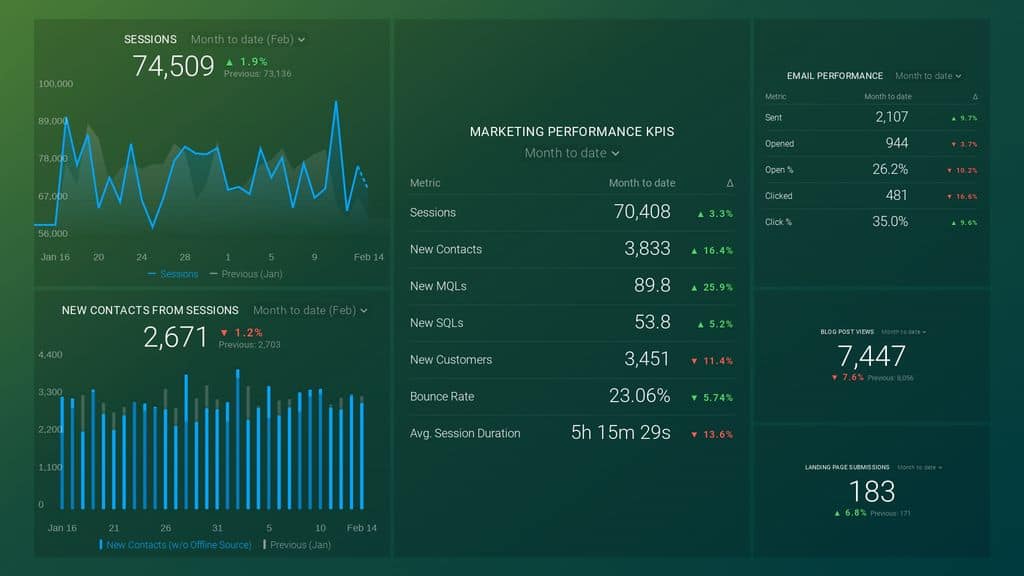
“Databox is reporting software that helps you measure business results,” says Daniel Daines-Hutt of AmpMyContent. “Rather than focus on one thing—like in Google Analytics—Databox tracks multiple things and builds them into a custom dashboard.”
“Right now, we have Databox paired up with a few things, but let me give you an example.”
“Our blog is all about content promotion. We just wrote this huge 30,000-word guide on how we promote content to a cold audience using paid ads. It took weeks to write, so we’re doing outreach and building links to the article.”
“We have a goal to build 100 linking domains to this article, but for every 100 people you do outreach to, you might not get more than 2-5 links. It can be slow going. You might get approved for a link, but it won’t show up in your rankings until weeks later.”
“So what can you do? Measure a more tangible goal instead.”
“We have Databox connected to Ahrefs and Mailshake. Ahrefs allows us to track our rankings and new links, and Mailshake allows us to do email outreach. We know that if we can send 16 outreach emails per day, we can get at least one new link each week. So that’s what we track.”
Browse through these free content marketing dashboard examples.
“We have a custom Databox dashboard that tracks:”
- “emails sent per day”
- “daily and weekly number of emails sent”
- “new links in last 90 days”
- “organic traffic and its changes”
“By focusing on that one simple task (have we sent enough emails), we know we’ll eventually hit those links. It gives us a metric to work on daily, and it shows up on our dashboard each day to let us know if we hit our goals.”
“And because we can set goals, we can get a dynamic graph that fills as we complete tasks. This encourages us to keep on going.”
“Link building and content promotion can be hard—not because the task itself is overly difficult, but because you’re working towards an end goal with no immediate visual feedback. By tracking our outreach efforts inside this custom dashboard software, it keeps us in one place and makes sure we get results.”
Not a Databox user yet? You can start by creating your free account here.
36. Atomic Reach
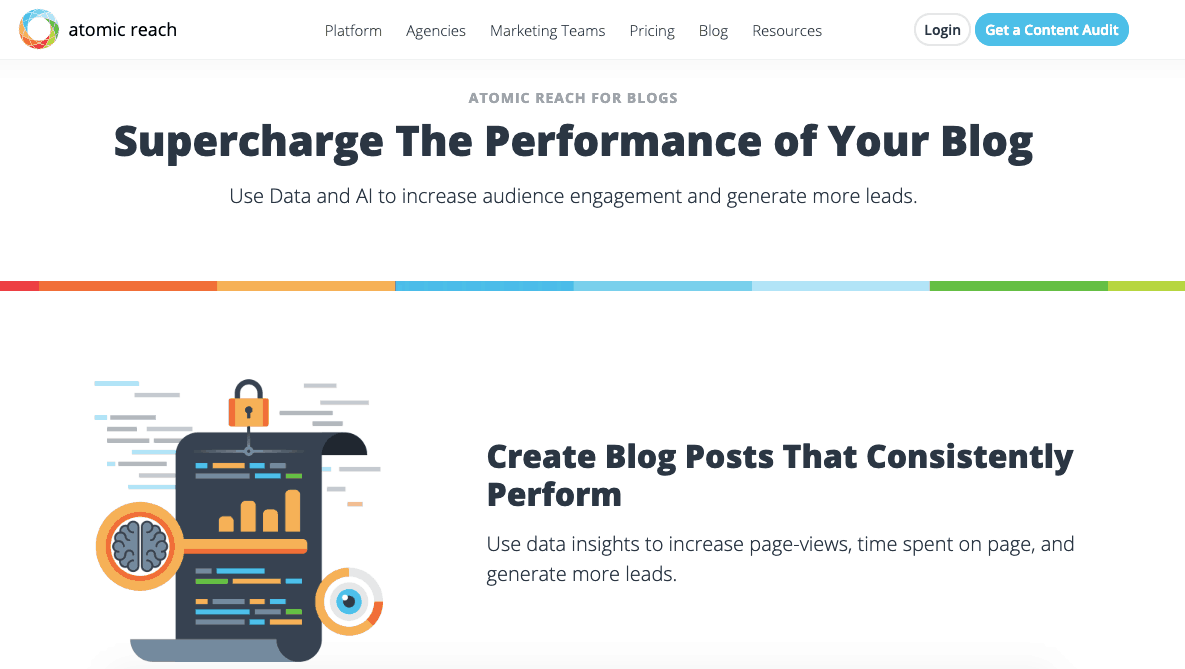
“Atomic Reach is a content intelligence platform that uses existing data from your content (blog post, emails, etc.) and presents you with a profile of which content performs best,” says Anne Shenton of Ascend Inbound Marketing.
“For example, you can see which reading level (beginner vs. academic), and which tone (calm vs. enthusiastic) of content performs better in terms of traffic, engagement, and conversions.”
“We’re finding that posts we publish using Atomic Reach receive twice as much traffic.”
37. AppsFlyer
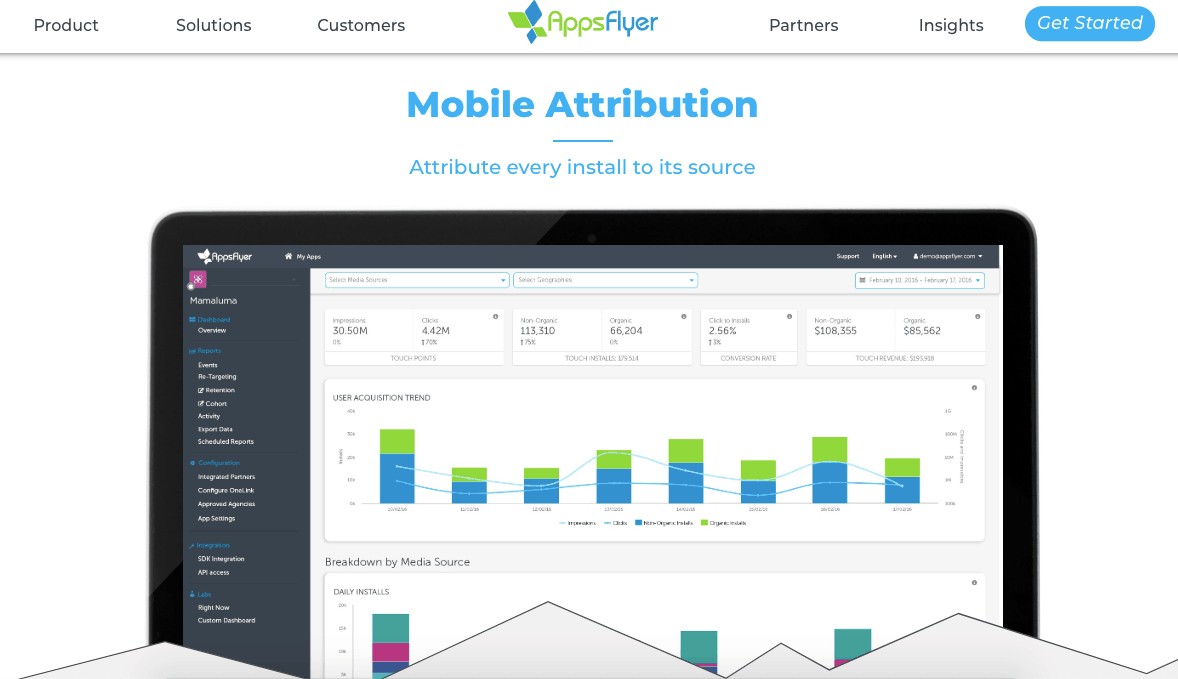
“AppsFlyer is an excellent marketing attribution tool for apps. It helps you discern which marketing channels are the most effective for your app,” says Josh Meah of JoshMeah, LLC.
“It’s notable for its breadth of integrations and capabilities, including deep-linking analytics. It’s a powerful tool for learning what content app users really want.”
“It’s helpful for tracking in-app activity, which lets me know which content is most appreciated by users inside of apps and further suggests which type of content my teams should develop. I also use it to assess which content marketing efforts are driving user-acquisition.”
“In the past, app marketing involved a lot of guesswork in terms of which content app users enjoyed and shared the most—and which content on which channels performed the best across KPIs. This issue is now effectively eliminated, which enables much more aggressive go-to-market campaigns and scalable plans based around content marketing.”
38. Amplitude
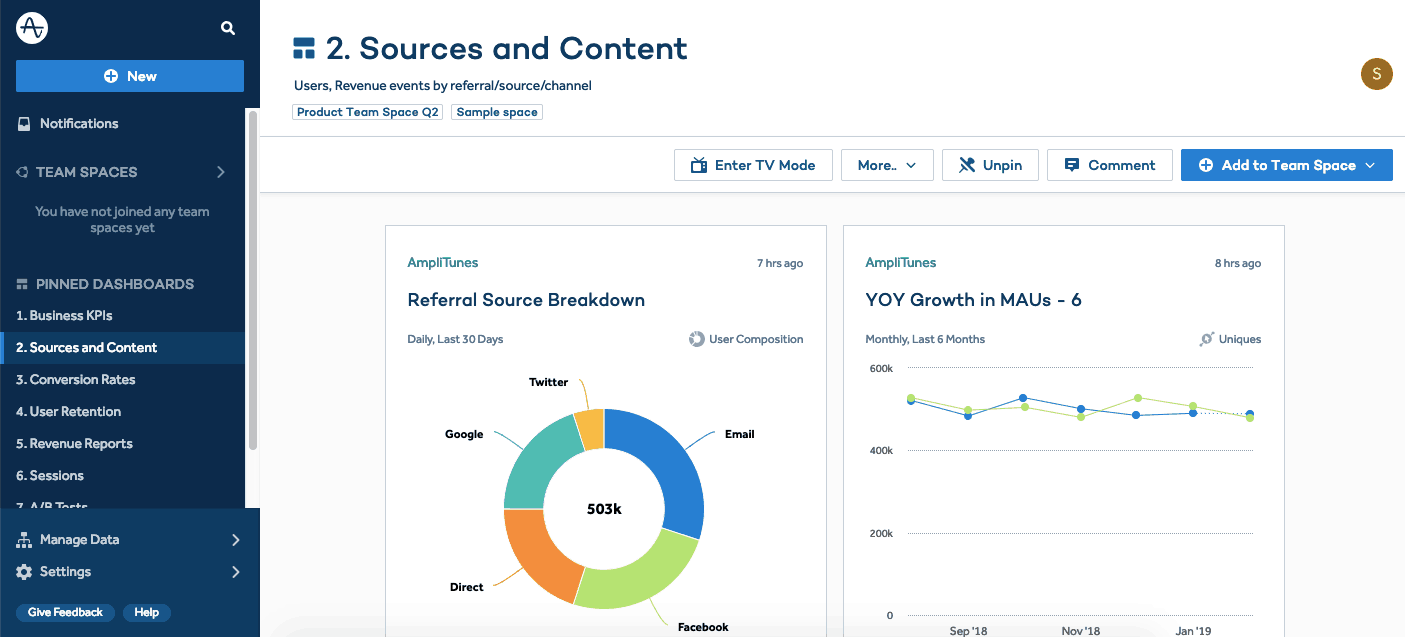
“We use Amplitude to measure the effectiveness of our campaigns,” says Kristen Craft of Tettra.
“I can see, for example, the account signup rate for those who’ve read a case study on our site versus those who haven’t, or those who’ve watched Tettra Academy content versus those who haven’t.”
“This has helped us determine where we should double down and which strategies we should put on hold. This means we’re more focused on the right tactics—and we get better results.”
How Much Should You Spend on Content Marketing Tools?
So with nearly 40 recommended ways to allocate some of your content marketing budget toward tools, the question becomes: “How much should you spend?”
While we can’t answer that question, we can show you how much our respondents report spending on content marketing software each month:
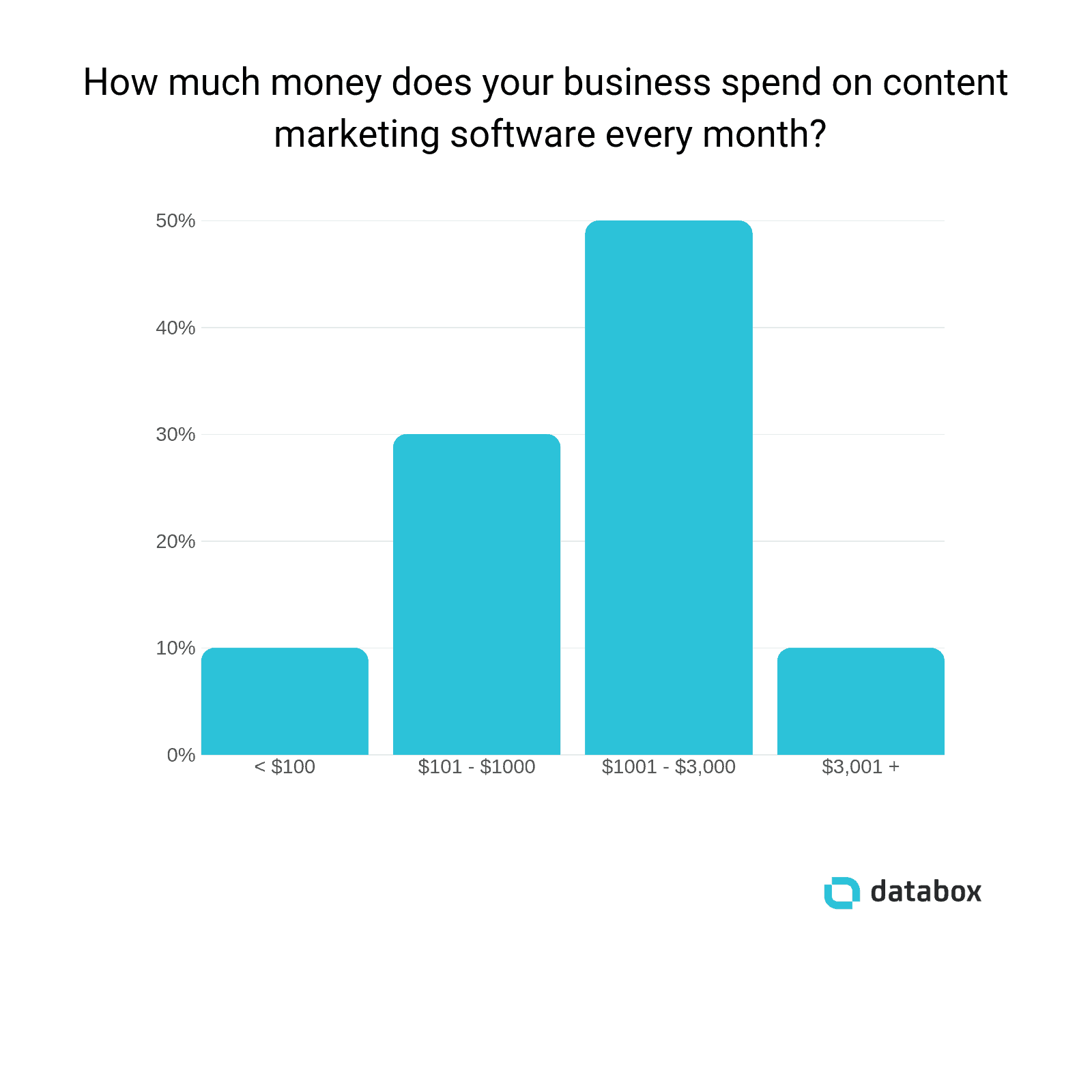
Half of our respondents spend between $1,001 and $3,000 on content marketing tools monthly.
And to provide some context around how that equates to volume of published content, we also asked our respondents how many pieces of content they publish each month:
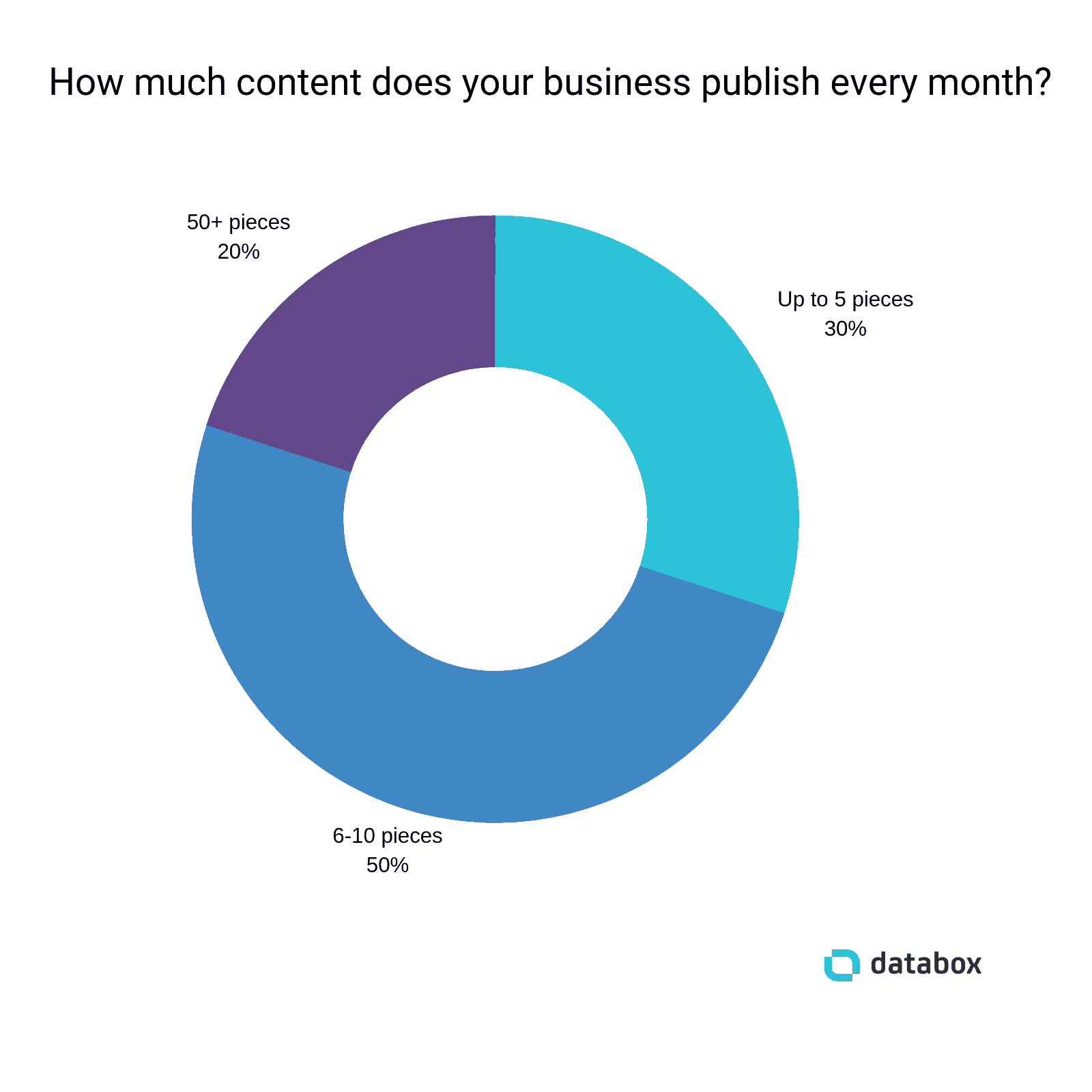
Half publish between six and ten new pieces of content each month.
So if you’re publishing more than five pieces of new content each month, it wouldn’t be unheard of to spend as much as $3,000 a month on content marketing tools. At the same time—as our results show—you can spend as little as $100 a month and still take advantage of some powerful content marketing tools.
In the end, the amount you spend—and the content marketing tools you choose—should be based on your specific needs, goals, and budget. Additionally, use this marketing automation dashboard to streamline your marketing efforts and make them more effective.








